
4
5
Fig. B
Fig. C
Fig. A
Grounded Tools: Tools with Three Prong Plugs
Tools marked “Grounding Required” have a three
wire cord and three prong grounding plug. The
plug must be connected to a properly grounded
outlet (See Figure A). If the tool should electrically
malfunction or break down, grounding provides a
low resistance path to carry electricity away from
the user, reducing the risk of electric shock.
The grounding prong in the plug is connected
through the green wire inside the cord to the
grounding system in the tool. The green wire in the
cord must be the only wire connected to the tool's
grounding system and must never be attached to
an electrically “live” terminal.
Your tool must be plugged into
an appropriate outlet, properly
installed and grounded in accord-
ance with all codes and ordinances.
The plug and outlet should look like
those in Figure A.
Double Insulated Tools:
Tools with Two Prong Plugs
Tools marked “Double Insulated” do not require
grounding. They have a special double insula-
tion system which satisfi es OSHA requirements
and complies with the applicable standards of
Underwriters Laboratories, Inc.,
the Canadian Standard Asso-
ciation and the National Elec-
trical Code. Double Insulated
tools may be used in either of
the 120 volt outlets shown in
Figures B and C.
Grounded tools require a three wire extension
cord. Double insulated tools can use either a two
or three wire extension cord. As the distance from
the supply outlet increases, you must use a heavier
gauge extension cord. Using extension cords with
inadequately sized wire causes a serious drop in
voltage, resulting in loss of power and possible tool
damage. Refer to the table shown to determine the
required minimum wire size.
The smaller the gauge number of the wire, the
greater the capacity of the cord. For example, a 14
gauge cord can carry a higher current than a 16
gauge cord. When using more than one extension
cord to make up the total length, be sure each cord
contains at least the minimum wire size required.
If you are using one extension cord for more than
one tool, add the nameplate amperes and use the
sum to determine the required minimum wire size.
Guidelines for Using Extension Cords
• If you are using an extension cord outdoors, be
sure it is marked with the suffi x “W-A” (“W” in
Canada) to indicate that it is acceptable for outdoor
use.
• Be sure your extension cord is properly wired
and in good electrical condition. Always replace a
damaged extension cord or have it repaired by a
qualifi ed person before using it.
• Protect your extension cords from sharp objects,
excessive heat and damp or wet areas.
READ AND SAVE ALL
INSTRUCTIONS FOR FUTURE USE.
* Based on limiting the line voltage drop to fi ve volts at
150% of the rated amperes.
EXTENSION CORDS
Recommended Minimum Wire Gauge
For Extension Cords*
Extension Cord Length
Nameplate
Amperes
25' 50' 75' 100' 150'
0 - 2.0
2.1 - 3.4
3.5 - 5.0
5.1 - 7.0
7.1 - 12.0
12.1 - 16.0
16.1 - 20.0
18
18
18
18
16
14
12
18
18
18
16
14
12
10
18
18
16
14
12
10
--
18
16
14
12
10
--
--
16
14
12
12
--
--
--
ASSEMBLY
WARNING To reduce the risk of injury,
always unplug tool before changing or re-
moving accessories. Only use accessories
specifi cally recommended for this tool. Others
may be hazardous.
OPERATION
Blades and Blade Selection
The blade dimensions required for the band saws
are: .020" thickness, 1/2" width and 44-7/8" in
length. The special .020" thickness reduces fl exure
fatigue and provides maximum tooth life. To maxi-
mize cutting life, use a blade with the correct pitch
(teeth per inch) for the specifi c cutting job.
Blades are available in several pitches. To select the
proper blade, three factors should be considered:
The size, shape, and type of material to be cut.
The following suggestions are for selecting the
right blade for various cutting operations. Keep in
mind that these are broad guidelines and that blade
requirements may vary depending upon the specifi c
size, shape and type of material to be cut. Gener-
ally, soft materials require coarse pitch blades and
hard materials require fi ne pitch blades. Use coarse
pitch blades for thick work and fi ne pitch blades for
thin work. It is important to keep at least three teeth
in the cut (see "Typical Application").
4. To install a new blade, with the pulleys facing up,
insert the blade between the rollers and the faces
of the guides, making sure that the teeth on the left
side of the tool point towards the rear of the tool.
5. With one hand, hold the blade in place between
the rollers and the guides and use the other hand
to position the blade around the pulleys. Be sure
that the blade lies freely within the guard channel
before starting the tool motor.
6. Turn the tension lock handle 180° clockwise to lock
the position. This will secure the blade on the pulleys.
BE SURE THAT THE BLADE IS PROPERLY
SEATED ON THE PULLEYS BEFORE START-
ING THE CUT.
Blade LED (Cat. No. 6232-20)
To line-up a cut or light-up the workpiece, use the
LED On/Off Switch.
Adjusting the 3-Position Material Guide
1. Unplug the tool.
2. Press in the guide adjustment button and slide
the material guide to the desired position detent.
• For tough stock 1/2" to 3-3/8" in
diameter or width (available in
carbon steel only).
• For tough stock 3/8" to 1" in
diameter or width (available in
carbon steel only).
• For tough stock 3/16" up to
4-3/4" in diameter or width.
• For tough stock 5/32" to 3/4" in
diameter or width.
• For thin-wall tubing and thin
sheets heavier than 21 gauge.
• For thin-wall tubing and thin
sheets heavier than 21 gauge.
Fig. 1
6 Teeth per Inch
8 Teeth per Inch
10 Teeth per Inch
14 Teeth per Inch
18 Teeth per Inch
24 Teeth per Inch
Changing Blades
1. UNPLUG THE TOOL BEFORE REMOVING OR
INSTALLING BLADES.
2. Turn the tension lock handle located on the front
of the saw 180° counterclockwise. This releases
the tension on the blade for easy removal.
3. Remove the blades from the pulley fi rst and then
from the guides.
WARNING To reduce the risk of injury,
wear safety goggles or glasses with side
shields. Keep hands away from the blade and
all moving parts.
WARNING To reduce the risk of injury,
always unplug tool before attaching or remov-
ing accessories or making adjustments. Use
only specifi cally recommended accessories.
Others may be hazardous.
Two Speed Switch (Cat. No. 6238-20)
MILWAUKEE Two-Speed Band Saws have a speed
change switch located on top of the handle. To
change speeds, stop the motor and slide the speed
change switch to "HI" or "LO" as indicated on the
tool. For cutting problem materials, use "LO" speed.
Never change from one speed to the other while
the motor is running.
Speed Dial (Cat. No. 6232-20)
MILWAUKEE Variable Speed Band Saws have a
speed dial located on the side of the handle to set
the maximum speed. Rotate the speed dial to “4”
for maximum speed, “1” for minimum speed.
Starting and Stopping
1. To start the tool, grasp both handles fi rmly and
pull the trigger.
GROUNDING
WARNING Improperly connecting the
grounding wire can result in the risk of elec-
tric shock. Check with a qualifi ed electrician
if you are in doubt as to whether the outlet is
properly grounded. Do not modify the plug
provided with the tool. Never remove the
grounding prong from the plug. Do not use
the tool if the cord or plug is damaged. If
damaged, have it repaired by a MILWAUKEE
service facility before use. If the plug will not
fi t the outlet, have a proper outlet installed by
a qualifi ed electrician.
WARNING Do not touch blade imme-
diately after use. Blade will be hot.
Fig. 2




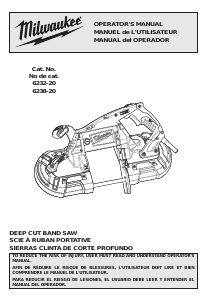
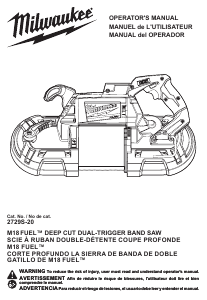
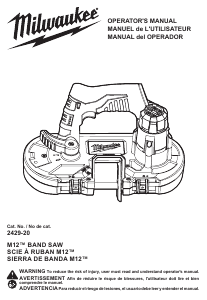
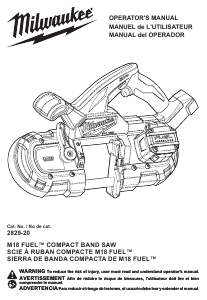
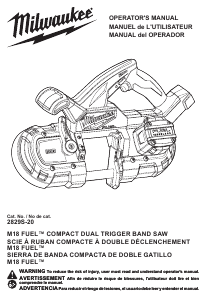
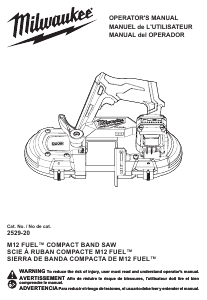
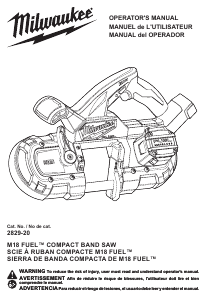
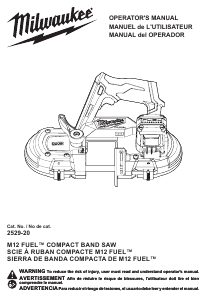
Únase a la conversación sobre este producto
Aquí puedes compartir lo que piensas sobre Milwaukee 6232-21 Sierra de cinta. Si tiene alguna pregunta, primero lea atentamente el manual. Puede solicitar un manual utilizando nuestro formulario de contacto.